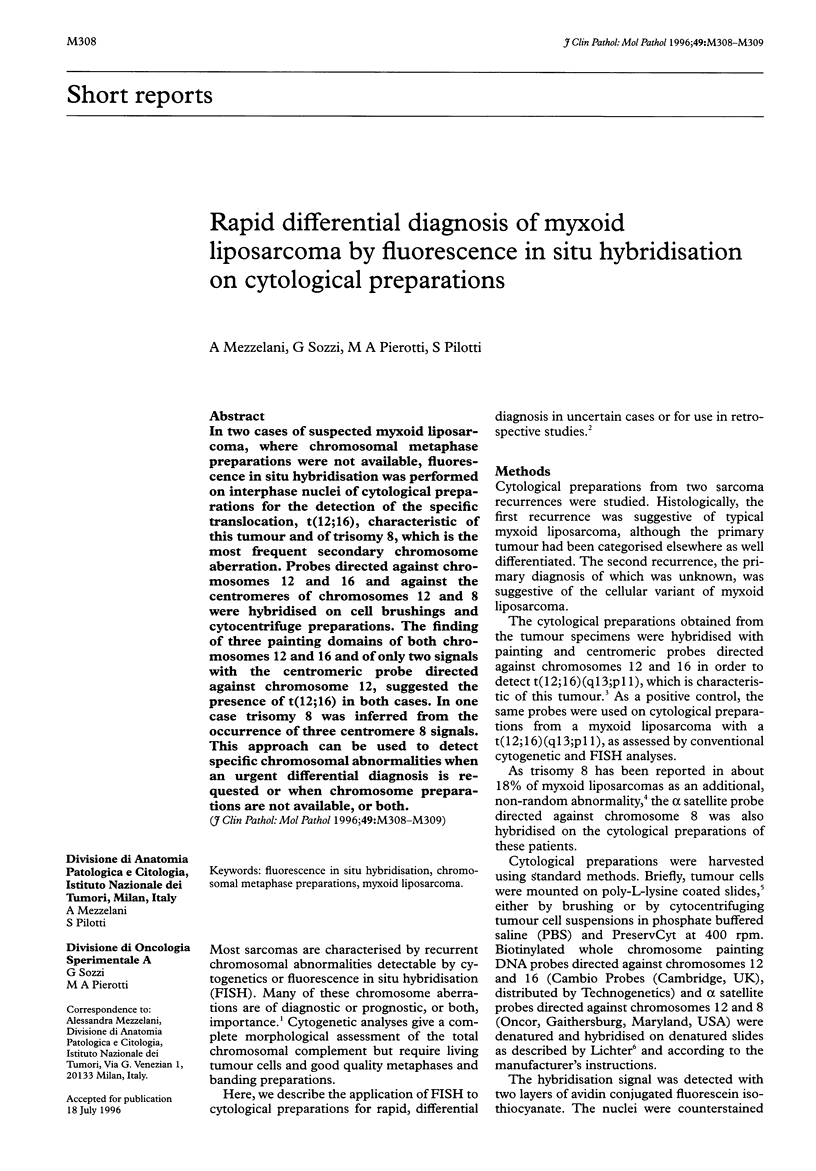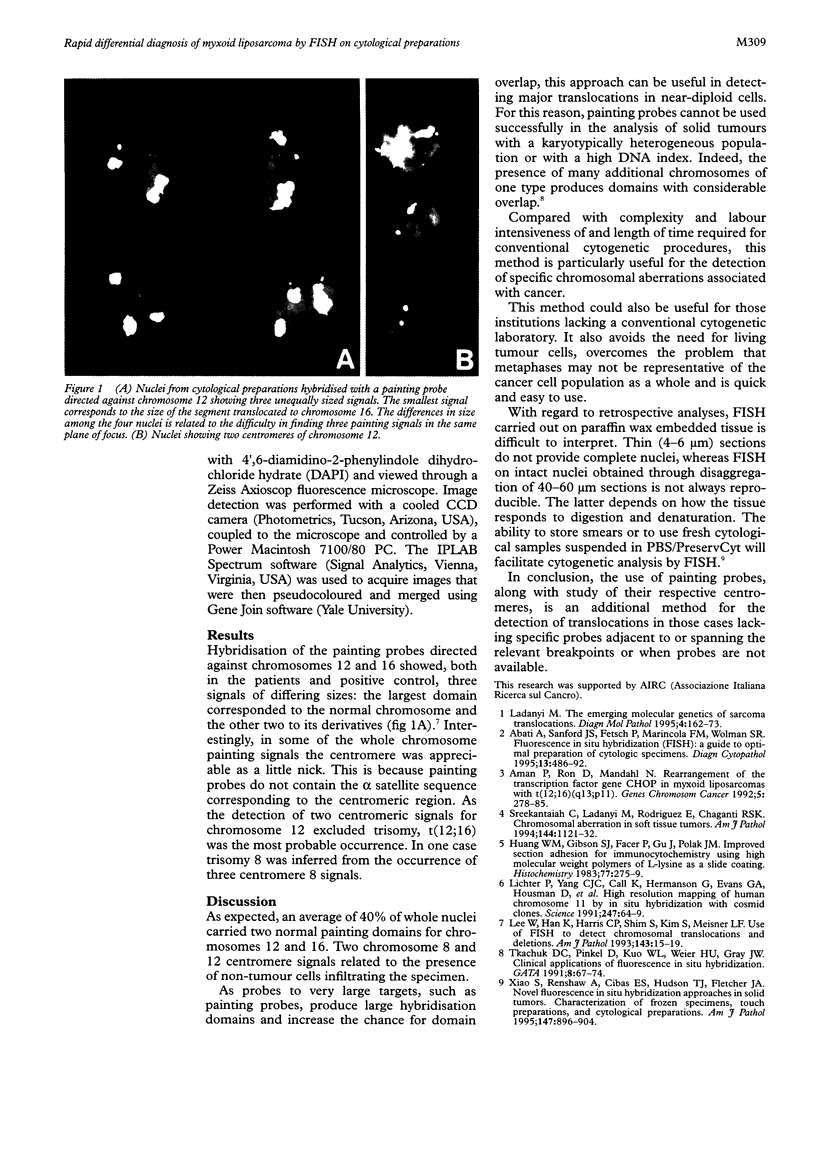Abstract
In two cases of suspected myxoid liposarcoma, where chromosomal metaphase preparations were not available, fluorescence in situ hybridisation was performed on interphase nuclei of cytological preparations for the detection of the specific translocation, t(12;16), characteristic of this tumour and of trisomy 8, which is the most frequent secondary chromosome aberration. Probes directed against chromosomes 12 and 16 and against the centromeres of chromosomes 12 and 8 were hybridised on cell brushings and cytocentrifuge preparations. The finding of three painting domains of both chromosomes 12 and 16 and of only two signals with the centromeric probe directed against chromosome 12, suggested the presence of t(12;16) in both cases. In one case trisomy 8 was inferred from the occurrence of three centromere 8 signals. This approach can be used to detect specific chromosomal abnormalities when an urgent differential diagnosis is requested or when chromosome preparations are not available, or both.
Keywords: fluorescence in situ hybridisation
Keywords: chromosomal metaphase preparations
Keywords: myxoid liposarcoma
Full text
PDF

Images in this article
Selected References
These references are in PubMed. This may not be the complete list of references from this article.
- Abati A., Sanford J. S., Fetsch P., Marincola F. M., Wolman S. R. Fluorescence in situ hybridization (FISH): a user's guide to optimal preparation of cytologic specimens. Diagn Cytopathol. 1995 Dec;13(5):486–492. doi: 10.1002/dc.2840130518. [DOI] [PubMed] [Google Scholar]
- Aman P., Ron D., Mandahl N., Fioretos T., Heim S., Arheden K., Willén H., Rydholm A., Mitelman F. Rearrangement of the transcription factor gene CHOP in myxoid liposarcomas with t(12;16)(q13;p11). Genes Chromosomes Cancer. 1992 Nov;5(4):278–285. doi: 10.1002/gcc.2870050403. [DOI] [PubMed] [Google Scholar]
- Huang W. M., Gibson S. J., Facer P., Gu J., Polak J. M. Improved section adhesion for immunocytochemistry using high molecular weight polymers of L-lysine as a slide coating. Histochemistry. 1983;77(2):275–279. doi: 10.1007/BF00506570. [DOI] [PubMed] [Google Scholar]
- Ladanyi M. The emerging molecular genetics of sarcoma translocations. Diagn Mol Pathol. 1995 Sep;4(3):162–173. doi: 10.1097/00019606-199509000-00003. [DOI] [PubMed] [Google Scholar]
- Lee W., Han K., Harris C. P., Shim S., Kim S., Meisner L. F. Use of FISH to detect chromosomal translocations and deletions. Analysis of chromosome rearrangement in synovial sarcoma cells from paraffin-embedded specimens. Am J Pathol. 1993 Jul;143(1):15–19. [PMC free article] [PubMed] [Google Scholar]
- Lichter P., Tang C. J., Call K., Hermanson G., Evans G. A., Housman D., Ward D. C. High-resolution mapping of human chromosome 11 by in situ hybridization with cosmid clones. Science. 1990 Jan 5;247(4938):64–69. doi: 10.1126/science.2294592. [DOI] [PubMed] [Google Scholar]
- Sreekantaiah C., Ladanyi M., Rodriguez E., Chaganti R. S. Chromosomal aberrations in soft tissue tumors. Relevance to diagnosis, classification, and molecular mechanisms. Am J Pathol. 1994 Jun;144(6):1121–1134. [PMC free article] [PubMed] [Google Scholar]
- Tkachuk D. C., Pinkel D., Kuo W. L., Weier H. U., Gray J. W. Clinical applications of fluorescence in situ hybridization. Genet Anal Tech Appl. 1991 Apr;8(2):67–74. doi: 10.1016/1050-3862(91)90051-r. [DOI] [PubMed] [Google Scholar]
- Xiao S., Renshaw A., Cibas E. S., Hudson T. J., Fletcher J. A. Novel fluorescence in situ hybridization approaches in solid tumors. Characterization of frozen specimens, touch preparations, and cytological preparations. Am J Pathol. 1995 Oct;147(4):896–904. [PMC free article] [PubMed] [Google Scholar]



